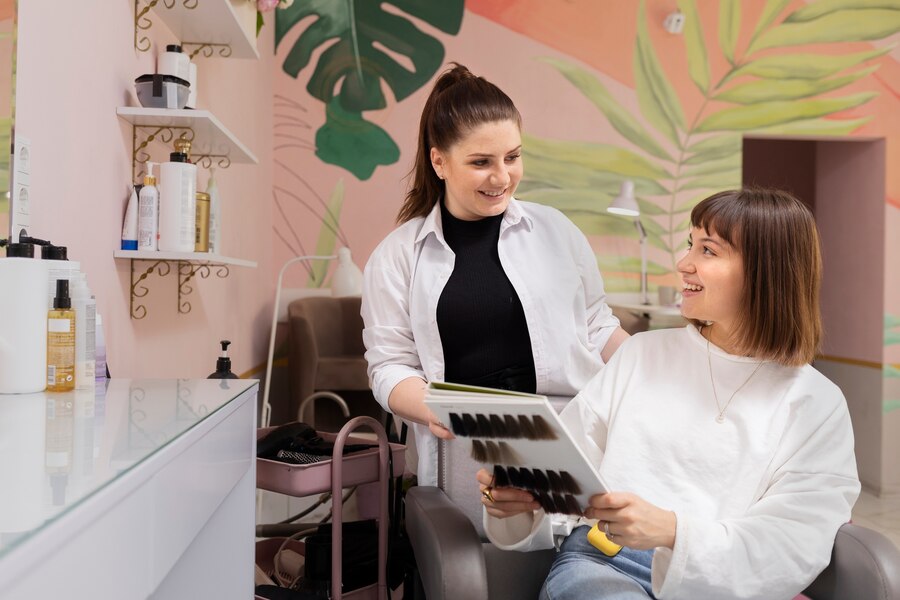Introduction:
Health And Beauty- Printing plays a pivotal role in the health and beauty industry, enabling effective communication of the myriad benefits offered by products and services in this dynamic sector. From cosmetic packaging to informative brochures and promotional materials, printed materials serve as powerful tools to convey messages, engage consumers, and enhance brand recognition. By utilizing sophisticated printing techniques and creative designs, businesses in the health and beauty industry can effectively communicate the advantages of their offerings, ultimately driving consumer interest and loyalty.
Through vibrant colors, captivating imagery, and carefully crafted content, printed materials help capture the attention of potential customers, enticing them to explore the benefits and unique features of various products. Whether it is a skincare product that promises a youthful glow, a hair care solution that guarantees luscious locks, or a wellness service that promotes overall well-being, printing enables businesses to articulate their value propositions and highlight the advantages that set them apart from competitors.
With meticulous attention to detail, printing can effectively convey the science, research, and testimonials behind health and beauty offerings, instilling confidence and trust among consumers. By leveraging innovative printing techniques such as embossing, foiling, and varnishing, brands can further elevate their packaging and promotional materials, creating a tactile and visually captivating experience that aligns with the luxurious nature of the industry.
What are the benefits of the beauty industry?
- The Beauty Industry is Growing
- Help Others Feel Confident
- Multiple Career Options
- Flexible Scheduling
- Practice What You Love Sooner
- Start Your Future in Beauty With Us
The beauty industry offers a plethora of benefits that extend beyond mere aesthetics. First and foremost, it plays a significant role in enhancing self-confidence and boosting self-esteem. Beauty products, treatments, and services have the power to transform individuals’ appearances, allowing them to feel more comfortable and confident in their own skin. This boost in self-confidence can have a profound impact on various aspects of life, from personal relationships to professional endeavors.
The beauty industry promotes self-care and wellness. Beauty routines, whether it involves skincare, haircare, or body care, encourage individuals to prioritize their well-being and engage in regular self-care practices. These rituals not only improve physical appearance but also provide moments of relaxation and rejuvenation. Pampering oneself with beauty treatments can alleviate stress, promote mental well-being, and serve as a form of self-expression and self-care. The beauty industry also has a significant economic impact, creating numerous job opportunities and contributing to economic growth. From product development and manufacturing to marketing and sales, the industry generates employment across various sectors.

What are the advantages of 3D printing in healthcare?
3D printing allows to 3D print medical and lab equipment. It is possible to 3D print plastic parts of the equipment. This drastically reduces costs and time spent waiting to receive a new medical device from external suppliers. Furthermore, the manufacturing process and further applications are also easier.
3D printing has revolutionized the healthcare industry by offering a multitude of advantages that have transformed patient care, medical research, and manufacturing processes. One of the key advantages of 3D printing in healthcare is its ability to produce patient-specific models and personalized medical devices. By utilizing medical imaging data, 3D printers can create precise anatomical models that aid in surgical planning, allowing surgeons to practice complex procedures and improve surgical outcomes. Additionally, 3D printing enables the customization and production of patient-specific implants, prosthetics, and orthotics, ensuring a perfect fit and enhancing patient comfort and mobility.
Traditional manufacturing processes can be time-consuming and costly, whereas 3D printing allows for quick iterations and modifications, accelerating the development and production of medical devices. This is particularly beneficial in emergency situations or for patients with unique anatomical structures that require customized solutions.
This opens up new possibilities for the design and manufacturing of medical implants, tissue scaffolds, and drug delivery systems. With 3D printing, it is feasible to create porous structures that promote tissue integration, patient-specific drug dosage forms, and even functional organs for transplantation in the future.
Why is technology important in beauty industry?
Beauty tech helps brands provide an omnichannel beauty experience by giving customers the ability to try on products virtually, as well as receive expert and personalized advice.
Technology plays a pivotal role in the beauty industry, revolutionizing the way products are developed, marketed, and consumed. It has become an essential tool for both consumers and professionals alike, driving innovation and transforming the industry in numerous ways. One of the key reasons why technology is important in the beauty industry is its ability to enhance product development and formulation.
Advanced scientific research and technological advancements have led to the creation of more effective and efficient beauty products, such as skincare treatments, haircare solutions, and cosmetics. By leveraging technology, beauty companies can explore new ingredients, test formulations, and analyze their efficacy, ultimately delivering higher-quality products to consumers. E-commerce platforms and mobile applications have made it easier than ever for consumers to explore and purchase a wide range of beauty products, often with personalized recommendations based on their individual needs and preferences.
Virtual try-on features allow customers to experiment with different makeup looks or hairstyles without physically trying them on, saving time and effort. Additionally, augmented reality (AR) and virtual reality (VR) technologies have transformed the in-store shopping experience, enabling customers to virtually test products and visualize how they would appear on their own faces or bodies.

How technology is changing the beauty industry?
AR and VR in the beauty industry enable more individualised customization. Who would have imagined that beauty products could be tested online? Augmented reality is being used by many cosmetic firms and apps to let customers test on makeup before purchasing. It is not necessary to visit a cosmetic or makeup store.
Technology is revolutionizing the beauty industry, bringing about profound changes in various aspects of the field. One significant way technology is transforming the beauty industry is through product development and customization. Advanced research and scientific breakthroughs have led to the creation of innovative skincare ingredients, haircare formulations, and cosmetic products that deliver superior results.
Technology allows for precise analysis of individual skin types and concerns, enabling the development of personalized beauty solutions tailored to specific needs. Additionally, the rise of artificial intelligence (AI) and machine learning has paved the way for virtual beauty assistants that provide personalized recommendations and advice to consumers, helping them make informed choices about products that suit their preferences and skin conditions.
Online marketplaces enable consumers to browse and purchase a vast range of beauty products from the comfort of their homes, with convenient features like subscription services and personalized product recommendations. Social media influencers and beauty bloggers play a crucial role in promoting products and shaping consumer preferences.
What is the positive impact of 3D printing on our health and the environment?
3D printing reduces carbon emissions, while traditional manufacturing increases pollution and waste released into environment, 3D printing reduces pollution by minimizing waste and carbon dioxide produced during the manufacturing process.
In the field of healthcare, 3D printing has paved the way for remarkable advancements. It enables the production of customized prosthetics, implants, and medical devices tailored to individual patients’ needs. This personalized approach not only enhances the comfort and functionality of these devices but also improves patients’ overall quality of life. Additionally, 3D printing has facilitated the creation of anatomical models, which assist surgeons in preoperative planning, leading to more precise and efficient surgeries, ultimately benefiting patient outcomes.
This approach minimizes material usage and reduces the environmental footprint associated with manufacturing. Furthermore, 3D printing enables the use of recyclable and biodegradable materials, contributing to a more sustainable production cycle.

What role does printing play in promoting consumer engagement?
Printing plays a crucial role in promoting consumer engagement by bridging the gap between digital and physical experiences. Despite the increasing digitization of media and marketing, print materials have remained relevant and effective in capturing consumers’ attention and fostering meaningful connections. Print materials such as brochures, catalogs, direct mail, and packaging provide tangible and sensory experiences that engage consumers on multiple levels.
One key aspect of print’s role in consumer engagement is its ability to create a tactile and immersive experience. Unlike digital content, printed materials allow consumers to physically interact with the brand.
The texture of the paper, the weight of the product, and the quality of the printing can all contribute to a sensory experience that evokes emotions and strengthens brand associations. Print materials can be designed creatively, incorporating visual elements, colors, and typography that resonate with the target audience and effectively convey the brand message.
How can printing convey the unique features of beauty products?
Printing can effectively convey the unique features of beauty products by employing various visual and textual elements that capture the essence and appeal of these products. Firstly, printing allows for high-quality graphics and vibrant colors, enabling the packaging of beauty products to showcase intricate details and eye-catching designs.
From intricate patterns and illustrations to mesmerizing product images, printing techniques such as lithography, flexography, and digital printing can create visually stunning packaging that grabs the attention of consumers. Moreover, printing offers the flexibility to experiment with different textures and finishes, such as embossing, foiling, and spot varnishing, which add a tactile dimension to the packaging, enhancing the perceived value and luxury of beauty products.
Through carefully crafted product descriptions, ingredient lists, and usage instructions, printing allows beauty brands to communicate the unique selling points and benefits of their products to potential customers. Utilizing typography, font styles, and sizes, printing can also convey the brand’s personality and positioning, whether it’s elegant and sophisticated or youthful and vibrant.

How can printing materials create a tactile and visually captivating experience?
Printing materials can create a tactile and visually captivating experience by utilizing various techniques and finishes that engage the senses and evoke a strong emotional response. Firstly, the choice of materials itself plays a crucial role. High-quality paper or cardstock with a smooth texture or specialized coatings can enhance the tactile experience, allowing users to feel the weight and quality of the printed piece. Additionally, printing techniques such as embossing and debossing can create raised or recessed patterns or textures on the surface, adding a tactile dimension that invites touch and exploration.
Spot varnishes can be applied selectively to highlight specific areas, creating a visually striking contrast between the coated and uncoated parts of a printed piece. Foil stamping can add a luxurious and eye-catching metallic effect, instantly drawing attention to key elements or details.
Special printing techniques like screen printing or letterpress can further elevate the tactile and visual experience. Screen printing allows for the use of textured inks and raised effects, resulting in a multi-dimensional and tactile surface. Letterpress, on the other hand, creates a deep impression on the paper, producing a visually striking and tactile result that showcases the craftsmanship involved.
Conclusion:
Printing serves as a powerful tool for the health and beauty industry, enabling effective communication of the multitude of benefits offered by its products and services. Through vibrant colors, captivating designs, and meticulous attention to detail, printing materials engage consumers, highlight unique features, and instill confidence in the efficacy of various offerings. By leveraging innovative printing techniques, businesses can create visually appealing packaging and promotional materials that leave a lasting impression.
They provide a tangible and tactile experience that fosters a personal connection between brands and consumers. Furthermore, printing allows for the communication of essential information such as ingredients, usage instructions, and scientific research, ensuring informed consumer choices and building trust.
As the industry evolves, printing remains an indispensable medium for effectively conveying the ever-changing landscape of health and beauty products. By leveraging the power of printing, businesses can successfully communicate the benefits of their offerings, drive consumer engagement, and establish a strong brand presence. In this dynamic sector, printing continues to be an invaluable tool for capturing attention, delivering persuasive messages, and fostering brand loyalty.

